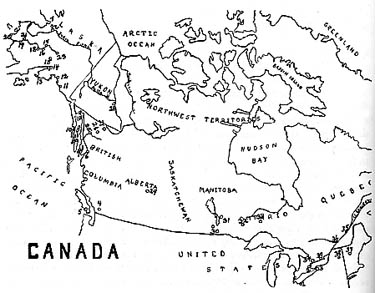 |
Key to Location of Indian and Eskimo Groups Examined in Canada
| 1. (Cleveland, Ohio) |
21. Bethel Island, Alaska |
| 2. Six Nation Indian Reservations, Ontario |
22. Holy Cross, Alaska |
| 3. Tuscarora Indian Reservations, New York |
23. McGrath, Alaska |
| 4. No. Vancouver Indian Reservation, British Columbia |
24. Eklutna, Alaska |
| 5. Craigflower Indian Reservation, Victoria, British Columbia |
25. Telegraph Creek, British Columbia |
| 6. Skeena River, British Columbia |
26. Dease Lake Indian Reservation, British Columbia |
| 7. Ketchikan, Alaska |
27. McDames, British Columbia |
| 8. Wrangell, Alaska |
28. Liard, British Columbia, Yukon Border |
| 9. Juneau, Alaska |
29. Edmonton, Alberta |
| 10. Sitka, Alaska |
30. Winnipeg, Manitoba |
| 11. Cordova, Alaska |
31. Broken Head Indian Reservation, Manitoba |
| 12. Valdez, Alaska |
32. Sioux Lookout, No. Ontario |
| 13. Seward, Alaska |
33. Ombabika, No. Ontario |
| 14. Anchorage, Alaska |
34. Toronto, Ontario |
| 15. Stoney River, Alaska |
35. Loretteville Reservation, Quebec |
| 16. Sleet Mute, Alaska |
36. Caughnawaga Reservation, Quebec |
| 17. Crooked Creek, Alaska |
37. Vergennes, Vermont |
| 18. Napaimute, Alaska |
38. Saranac Tuberculosis Sanitarium, New York |
| 19. Bethel, Alaska |
39. Mohawk Reservation, Ontario |
| 20. Kokamute, Alaska |
|
Chapter 5
Isolated and modernized Eskimos
DURING the rise and fall of historic and prehistoric cultures that have often left their monuments and arts following each other in succession in the same location, one culture, the Eskimo, living on until today, brings us a robust sample of the Stone Age people. The Maya race is gone, but has left its monuments. The Indian race is rapidly changing or disappearing in North America. The Eskimo race has remained true to ancestral type to give us a living demonstration of what Nature can do in the building of a race competent to withstand for thousands of years the rigors of an Arctic climate. Like the Indian, the Eskimo thrived as long as he was not blighted by the touch of modern civilization, but with it, like all primitives, he withers and dies.
In his primitive state he has provided an example of physical excellence and dental perfection such as has seldom been excelled by any race in the past or present. We are concerned to know the secret of this great achievement since his circumscribed life greatly reduces the factors that may enter as controlling units in molding this excellence. While we are primarily concerned in this study with the characteristics of the Eskimo dentition and facial form and the effect upon it of his contact with modern civilization, we are also deeply concerned to know the formula of his nutrition in order that we may learn from it the secrets that will not only aid the unfortunate modern or so-called civilized races, but will also, if possible, provide means for assisting in their preservation.
It is a sad commentary that with the coming of the white man the Eskimos and Indians are rapidly reduced both in numbers and physical excellence by the white man's diseases. We have few problems more urgent or more challenging than that means shall soon be found for preventing the extermination of the primitive Americans. Many reports have been made with regard to the condition of the teeth of the Eskimos. Doubtless, all have been relatively authentic for the groups studied, which have been chiefly along the routes of commerce. Clearly those people would not represent the most primitive groups, which could only be located beyond the reach of contact with modern civilization. The problems involved strongly suggested the desirability of locating and studying Eskimos in isolated districts. While dog teams could furnish means of approach in the winter season, they would not be available for summer travel.
Through the kindness of Dr. Alexis Hrdlicka, who has made anthropological studies of the Eskimos in many of the districts of Alaska, I learned that the most primitive groups were located south of the Yukon in the country between it and Bristol Bay including the Delta and mouth of the Kuskokwim River. A government station has been established on the Kuskokwim River for which a government boat enters the mouth of the Kuskokwim to deliver supplies. It carries officials, but not passengers. This contact with civilization has made available modern foods for a limited district, chiefly at the point at which the boat lands, namely, Bethel. A portion of these supplies is transported by a stern-wheel river boat to settlements farther up the river. A great number, however, of Eskimos live between the mouth of the Kuskokwim and the mouth of the Yukon River, on the mainland and islands, a distance of several hundred miles, and have little or no contact with this food.
Accordingly, our program for making these field studies among the Eskimos in 1933 required transportation over long distances and into districts where travelling facilities were practically non-existent by other means than by modern aeroplane. Mrs. Price accompanies and assists me with my records. Our itinerary included steamship service to Seward in western Alaska and railway to Anchorage, where an aeroplane was chartered which carried us to various districts in western and central Alaska. This plane carried our field equipment, and travelled to the points selected. The great Alaska mountain range, culminating in the magnificent Mt. McKinley, stretches across Alaska from the Aleutian Peninsula at the southwest far into the heart of this vast territory. The highest mountain in the United States proper is Mt. Whitney, 14,502 feet. The highest mountain in Canada is Mt. Logan, 19,539 feet. Alaska, however, boasts many mountains that are higher than any of these, many of which are in this range. Mt. McKinley is 20,300 feet. It was necessary for us to surmount this magnificent range to reach the territory in which our investigations were to be made. The special aeroplane selected was equipped with radio for both sending and receiving, and was in touch, or could be in touch at all times, with the Signal Service Corps, as well as with the headquarters and branches of the Company. Owing to clouds in the selected pass, the pilot found it necessary to go one hundred fifty miles out of his course to find one that was clear enough to fly through. Beyond these mountains were vast areas of bare wilderness with no signs of human life. Moose were frequently seen.
Our first objective was to find, if possible, a band of Indians reported to live on Stony River. They had been described as being very primitive. Our pilot, who was well informed about this region, said this was the first time he had even landed in this district. All the people were busy catching and storing the running salmon. After drying the fish they are smoked for a few hours and then stored for winter use. These thrifty people have physical features quite unlike the Indians of central, southern and eastern Alaska. Of the twelve individuals studied here, ten had lived entirely on the native foods or practically so. In their 288 teeth only one tooth was found that had ever been attacked by tooth decay, or 0.3 per cent. Two had come up from the Kuskokwim River, of which the Stony River is a branch. There, they had received a considerable quantity of the "store grub" that had been shipped up the Kuskokwim from Bethel. Twenty-seven per cent of the teeth of these two had been attacked by dental caries.
We then proceeded to Sleet Mute, on the Kuskokwim River, where three individuals were found who had lived entirely on native foods. None of them had ever had a tooth attacked by tooth decay. Seven others had lived partly on native foods and partly on "store grub," and they had dental caries in 12.2 per cent of their teeth.
At Crooked Creek, the next settlement, eight individuals were examined and of their 216 teeth forty-one, or 18.9 per cent, had caries. All but one of these were living in considerable part on "store grub," and this individual had no dental caries.
At Napimute, 16 per cent of the teeth had been attacked by dental caries, but no individuals studied here were living entirely on native foods.
Bethel is the largest settlement on the Kuskokwim, and contains in addition to the white residents many visiting Eskimos from the nearby Tundra country surrounding it. Eighty-eight individuals studied here were largely Eskimos and mixed bloods. Of their 2,490 teeth, 11.6 per cent, or 281 teeth, had been attacked by tooth decay. Of these eighty-eight individuals twenty-seven with 796 teeth had lived almost exclusively on natural foods, and in this group only one tooth was found with dental caries, or 0.1 per cent. Forty individuals were living almost exclusively on modern foods as shipped in by the government supply boat. Of their 1,094 teeth, 252, or 21.1 per cent, had been attacked by tooth decay. Twenty-one individuals were living partly on native foods and partly on "store grub," and of their 600 teeth thirty-eight, or 6.3 per cent, had been attacked by tooth decay.
At Kokamute, on the Bering Sea at the mouth of the Kuskokwim River, a large band of very primitive Eskimos was studied. They had come from the vicinity of Nelson Island, a district which has had exceedingly little contact with modern civilization. In this group twenty-eight individuals with 820 teeth showed only one tooth, or 0.1 per cent, that had ever been attacked by dental caries.
Bethel Island is situated in the Kuskokwim River. It is visited in the summer by Eskimos from the Tundra Country for laying in their store of fish for winter use. Of fifteen individuals here, thirteen, with 410 teeth, had lived exclusively on native foods, and not a single tooth had been attacked by dental caries. Two had come from Bethel, and of their sixty teeth twenty-one or 35 per cent had been attacked by tooth decay.
In the various groups in the lower Kuskokwim seventy-two individuals who were living exclusively on native foods had in their 2,138 teeth only two teeth or 0.09 per cent that had ever been attacked by tooth decay. In this district eighty-one individuals were studied who had been living in part or in considerable part on modern foods, and of their 2,254 teeth 394 or 13 per cent had been attacked by dental caries. This represents an increase in dental caries of 144 fold.
It next became desirable to study a district that had been in contact with the foods of modern commerce for many years, and for this Holy Cross was selected. This community is located on the Yukon River above the Arctic Circle. It has been in contact with the summer commerce of the Yukon for several decades. It has one of the oldest and best organized Catholic Missions of Alaska. The individuals studied were all in the school connected with the Mission. The students had come from as far north as Point Barrow on the Arctic Ocean and west to the Bering Straits. All but one had been in contact with and had used modern foods before coming to the Mission, and were using them while there. This one individual had lived exclusively on native foods before coming to the Mission and he had no carious teeth. In eight individuals with 224 teeth, who had lived very largely on modern foods, forty-two teeth or 18.7 per cent had been attacked by tooth decay. Four individuals had lived partly on native foods and partly on modern foods, and of their 112 teeth four, or 3.5 per cent, had been attacked by tooth decay.
It is of interest that while the Eskimos and Indians have lived in accord, they have not intermarried. The Eskimos occupy the lower section of the Yukon and Kuskokwim Rivers, and the Bering Sea frontier. The Indians have occupied the Upper waterways of both these rivers. The next place selected for study was McGrath, which is on the Upper Kuskokwim not far distant from the McKinley Mountain Range. It is the upper terminus of navigation on the Kuskokwim River for the stern-wheel river boats. Its chief importance lies in the fact that it is the division point on the Cross Alaska Aeroplane Routes from Anchorage or Fairbanks to Nome and other western points. Its population consists of several white prospectors and miners who have stayed in the country following the gold rush. Some of them have married Indian and Eskimo women. Of twenty-one individuals only one had lived almost exclusively on native foods and she had no dental caries. Twenty had lived chiefly on imported foods, and of their 527 teeth 175, or 33.2 per cent, had been attacked by tooth decay.
Among the residents of McGrath there is a remarkable family. The father is an American mining engineer who has spent much of his life in that country. His wife is a charming Eskimo woman of splendid intelligence and fine personality. She had come originally from the lower Kuskokwim and was one of the primitive Eskimo stock. While mining interests had provided food supplies for the family, shipped from the United States, she followed her early training and insisted on catching and storing salmon in season as an important part of her own dietary. The salmon were dried and smoked as was the custom of her people. She is the mother of at least twenty children, for she could give the names of that many. Only eleven were living, however, several having died from tuberculosis. Notwithstanding her many overloads, not a single tooth had ever been attacked by tooth decay. A lower anterior tooth had been broken. A picture of this woman is shown in Fig. 9 (upper, left). There has been extensive wear of the teeth, as is characteristic of the teeth of many of the Eskimos, a matter which we will presently discuss. It is of interest to note the splendid symmetry of her dental arches. Her children and husband and son-in-law had lived very largely on modern foods and in these eight individuals with 212 teeth eighty-seven, or 41 per cent, had been attacked by tooth decay. Her oldest living daughter is twenty-two years of age. She has a narrowing of the upper arch and extensive tooth decay. Another daughter, sixteen, is a beautiful girl except for her narrow dental arches. She was reported by our pilot to have become so deeply interested in the engines of the aircrafts as they stopped at this point for servicing and fuel that she had become expert in tuning up and conditioning aeroplane motors. She, doubtless, inherited some of the genius of her father, who is a mining engineer. Twelve of her teeth had been attacked by dental caries.
FIG. 9. Typical native Alaskan Eskimos. Note the broad faces and broad arches and no dental caries (tooth decay). Upper left, woman has a broken lower tooth. She has had twenty-six children with no tooth decay.
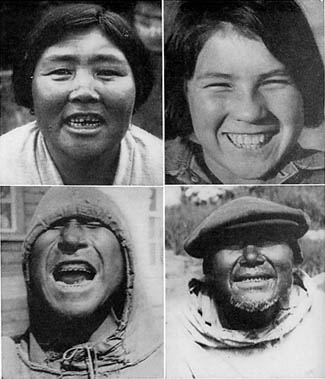 |
One does not get a conception of the magnificent dental development of the more primitive Eskimos simply by learning that they have freedom from dental caries. The size and strength of the mandible, the breadth of the face and the strength of the muscles of mastication all reach a degree of excellence that is seldom seen in other races. This is typically illustrated in Fig. 9. I was told that an average adult Eskimo man can carry one hundred pounds in each hand and one hundred pounds in his teeth with ease for a considerable distance. This illustrates the physical development of other parts of the body as well as the jaws, and suggests that the exercising of the jaws is not the sole reason for their very fine teeth, since the superb development of the musculature includes all parts of the body. It has also been suggested that chewing of tough foods, by building teeth of exceptionally fine quality, has been an important factor in the establishment of immunity to caries. As will be shown presently, the teeth of these individuals with their excellent physical development and fine tooth structure develop caries when they depart from their native foods and adopt our modern foods.
Much has been reported in the literature of the excessive wear of the Eskimos' teeth, which in the case of the women has been ascribed to the chewing of the leather in the process of tanning. It is of interest that while many of the teeth studied gave evidence of excessive wear involving the crowns to a depth that in many individuals would have exposed the pulps, there was in no case an open pulp chamber. They were always filled with secondary dentin. This is important since our newer knowledge indicates that with the chemical characteristics of their food we might expect that secondary dentin would be readily formed within the pulp chambers by a process similar to that which occurs in many individuals under a diet reinforced with mineral and activator-providing foods. One old Eskimo had a scar on his lower lip, which was the result of perforations for carrying a decoration as practiced by his tribe. I have found primitive tribes in several parts of the world with this marking.
The principal outer garment worn by the Eskimo for the more primitive groups consists of a parka carrying a hood which is pulled over the head and closed around the neck with a shirr string, while another shirr string controls the size of the face opening in the hood when it is up. In the summer this is made of cloth or of skin without the fur. A typical case is shown in Fig. 9. It will again be noted that the teeth are excessively worn.
FIG. 10. These primitive Alaskan mothers rear strong, rugged babies. The mothers do not suffer from dental caries.
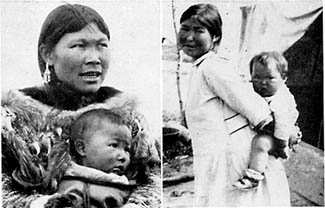 |
Owing to the bleakness of the winds off the Bering Sea, even in the summer many of the women wear furs. A typical mother and child dressed in their warm clothing are shown in Fig. 10. The Eskimo women are both artistic and skillful in needle work. They use fur of different colors for decorating their garments. These women make artistic decorations by carving ivory from walrus teeth and from the buried tusks of the hairy mammoth that wandered over the Tundra tens of thousands of years ago. The ear decoration of this Eskimo woman is a typical design. This mother's teeth are literally "two rows of pearls." It is important to note the width of the arches. One is continually impressed with the magnificent health of the child life which is illustrated in Fig. 10. In our various contacts with them we never heard an Eskimo child crying except when hungry, or frightened by the presence of strangers. The women are characterized by the abundance of breastfood which almost always develops normally and is maintained without difficulty for a year. The mothers were completely free of dental caries, and I was told that the children of the Eskimos have no difficulties with the cutting of their teeth.
FIG. 11. When the primitive Alaskan Eskimos obtain the white man's foods, dental caries become active. Pyorrhea also often becomes severe. In many districts dental service cannot be obtained and suffering is acute and prolonged.
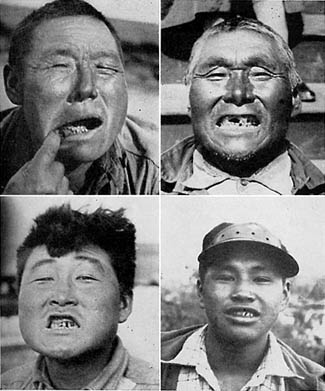 |
The excellence of dentitions among the Eskimos has been a characteristic also of the skulls that have been excavated in various parts of Alaska.
It might be expected that such wonderfully formed teeth would maintain so high an immunity to dental caries that their proud possessors would never be troubled with tooth decay. This, unfortunately, is not the case, a fact of great significance in evaluating our modern theories of the causes of dental caries. When these adult Eskimos exchange their foods for our modern foods, which we will discuss in Chapter 15, they often have very extensive tooth decay and suffer severely. This is clearly illustrated in Fig. 11, for these Eskimos' teeth had been seriously wrecked by tooth decay. They had been living on modern foods and were typical of a large number who are in contact with the Bering Sea ports. Their plight often becomes tragic since there are no dentists in these districts.
A typical effect of modernization on a growing girl was shown in a case in which the central incisors and 16 other teeth were attacked by dental caries. Sixty-four per cent of her teeth had tooth decay.
There are no dentists in western Alaska, north or west of Anchorage, which is near the southern coast, except at Fairbanks which, like Anchorage, is many hundreds of miles from these Eskimos. It would take months for them to make the journey in winter by dog team, and it would be practically impossible to make it in the summer season by any means of travel except by aeroplane, which clearly these people could not afford. Their dilemma is, accordingly, most tragic when they suddenly become victims of diseases which require hospitalization or skilled medical or dental service. One mining engineer in the interior told me that he had spent two thousand dollars to have a dentist brought in by aeroplane to render dental service. On my examination of his mouth I found twenty-nine of his thirty-two teeth had been attacked by dental caries.
One important phase of modern degeneration, namely, change in facial and dental arch form and other physical expressions, is of interest. It is a matter of great significance that the Eskimos who are living in isolated districts and on native foods have produced uniformly broad dental arches and typical Eskimo facial patterns. Even the first generation forsaking that diet and using the modern diet, presents large numbers of individuals with marked changes in facial and dental arch form. In Fig. 12 will be seen four Eskimo girls who are of the first generation following the adoption of modernized foods by their parents. All have deformed dental arches. It is important to note the pattern of the settling inward of the lateral incisors and the crowding outward of the cuspids. This facial design is currently assigned to a mixing of racial bloods. These girls are pure-blooded Eskimos whose parents have normally formed dental arches.
FIG. 12. While dental arch deformities or crowded teeth are practically unknown among many of the primitive groups of Eskimos, they occur frequently in the first generation of children born after the parents have adopted the white man's foods. Note the narrow nostrils and changed facial form of these children. This is not due to thumb sucking.
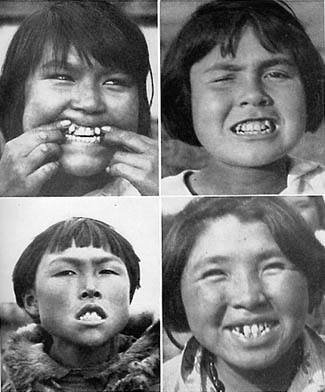 |
We are particularly concerned with the foods used by these primitive Eskimos. They almost always have their homes on or near deep water. Their skill in handling their kayaks is most remarkable. During the salmon running season they store large quantities of dried salmon. They spear many of these fish from their kayaks; even young boys are very skillful. They land salmon so large that they can hardly lift them. They are expert in spearing seals from these light crafts. Seal oil provides a very important part of their nutrition. As each piece of fish is broken off, it is dipped in seal oil. I obtained some seal oil from them and brought it to my laboratory for analyzing for its vitamin content. It proved to be one of the richest foods in vitamin A that I have found.
The fish are hung on racks in the wind for drying. Fish eggs are also spread out to dry, as shown in Fig. 13. These foods constitute a very important part of the nutrition of the small children after they are weaned. Naturally, the drifting sands of the bleak Bering Straits lodge upon and cling to the moist surfaces of the fish that are hung up to dry. This constitutes the principal cause for the excessive wear of the Eskimos' teeth in both men and women.
FIG. 13. The eggs of the salmon are dried and stored as an important item of nutrition for both children and adults. They are also used to increase the fertility of the women. From a chemical standpoint they are one of the most nutritious foods I have found anywhere.
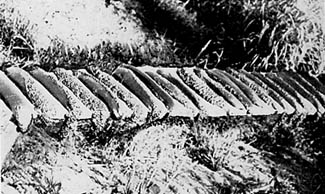 |
The food of these Eskimos in their native state includes caribou, ground nuts which are gathered by mice and stored in caches, kelp which is gathered in season and stored for winter use, berries including cranberries which are preserved by freezing, blossoms of flowers preserved in seal oil, sorrel grass preserved in seal oil, and quantities of frozen fish. Another important food factor consists of the organs of the large animals of the sea, including certain layers of the skin of one of the species of whale, which has been found to be very high in vitamin C.
Since contact with our modern civilization, the Eskimo population for Alaska is very rapidly declining. One authority has quoted the reduction of 50 per cent in population in seventy-five years.
An important observation has been made relative to the rapid shortening of the average life by Dr. V. E. Levine and Professor C. W. Bauer, of Creighton University, Nebraska, who reported:
Cordova, Alaska, Oct. 26, 1934--Due to susceptibility to tuberculosis and other diseases the average life span of the Eskimo of Alaska is only 20 years and their race is doomed to extinction within a few generations unless modern medical science comes to their aid.
Unless a very radical change is made in the interference with the native supply of game and sea foods, the Eskimo population seems destined to have a rapid decline and an early extinction. Their primitive fish foods have been largely curtailed by the encroachment on their salmon streams made by modern canneries.
It is of interest to discuss in connection with the Alaskan Eskimo two white boys (one is shown in Fig. 14), who were sons of a mining engineer. They had been born and raised in a mining camp in Alaska, where their foods had been almost entirely shipped in. I travelled with the mother of these two boys who was bringing them to the United States for operations on their noses, because they were mouth-breathers. It is important to observe the marked underdevelopment of both the middle third and lower third of the face of the boy shown in Fig. 14. The nutrition of the family during their development and growth had been largely provided in package form shipped in from the United States. Their disfiguration is typical of that of large numbers that are developing in our highly modernized communities, and is similar, in general, to the deformities which develop in the primitive races after they adopt the modernized nutrition.
FIG. 14. This white boy was born and raised in Alaska on imported foods. His facial deformity includes a lack of development of the air passages, so that he breathes through his mouth. Lack of bone development creates the crowded condition of the teeth. Note his narrow nostrils.
 |
Notwithstanding the very inhospitable part of the world in which they reside, with nine or ten months of winter and only two or three of summer, and in spite of the absence for long periods of plant foods and dairy products and eggs, the Eskimos were able to provide their bodies with all the mineral and vitamin requirements from sea foods, stored greens and berries and plants from the sea.
Next
Table of Contents
Back to the Small Farms Library






